|
【旧ソ連邦の民間伝承音楽】-Audio CD版-
Russian and Non-Russian Folklore on Audio CD
from the Pushkinskii Dom Phonogram Archive of the Russian Academy of Sciences
in St.Petersburg.
以下に示します音声記録は,ペテルブルクにあるロシア科学アカデミー・プーシキン記念館の音響文字アーカイブ所有の所蔵品で、1916年頃より色々な研究旅行で集められた独特で稀な資料を含んでおります。全てのオリジナル・レコードはこの版のために再マスターが取られ,民族学者,人類学者,音楽学者,言語学者及びスラブ学研究家より多くの感心を寄せられております。一番目は,多くの言語や文化を代表する音響資料で、大切であり,その殆どが失われていたかも知れません。 記録の歴史的な性質として,二番目も同じように大切であり本来のものです。三番目は極東ロシアとシベリアに土着の人々の言語と文化を表しております。これらの記録の歴史的及び民族学的な価値は非常に重要であり,入手不可能な物かも知れませんし,旧アジア人、満州-ツングース人とウラル民族と其の言語がこの地球より急速に滅亡しかかっております。本資料は又、ロシア、ベラルーシュとウクライナの伝統的な民俗音楽、バラード、呪文、哀悼歌、子守歌と他の伝統的な歌がベラルーシュ(白ロシア)ゴメル地方の住民によって演じられたものです。 下記にてSeries I-II のサンプルをご試聴ください 弊社日本販売総代理店商品
これらは、1916年頃から現地で収録された非常に珍しい民俗音楽をCDに収めたもので
音質も極めて良好です。民俗学者・人類学者・音楽家・言語学者・スラブ研究者に
とって、極めて興味のあるものと存じます。
Series I – III シリーズ全体一括ご購入の場合 ¥199,000 (¥218,900 税込)
Series I : Non-Russian Folk Traditions (10 titles, 12 discs) 非ロシア民俗伝統 ¥66,000. (¥72,600 税込)
| 1. |
Алтайский эпос(на 2-х дисках) Altaic Epos (2-disc set):アルタイ語系の叙事詩 |
| |
The Altaians and the indigenous population of the Altai Republic are a Turkic-speaking people who have managed to preserve the purity of teir own ancient culture. The set presents brilliantly performed monuments of their epic heritage. According to the 1989 census there were 59,130 Altaians. |
|
|
|
|
| 2. |
Anthology of Buryat Folklore:ブリアート民俗名曲集 |
| |
The Buryats, numbering approximately 350,000, are the largest ethnic minority group in Siberia. The traditional Buryats were shamanists. The interactions of Buddhism and Christianity have shaped the Buryat culture. |
| |
|
| 3. |
Антология якутского фольклора
Anthology of Yakutsk[ Folklore:ヤクーツク民俗名曲集 |
| |
The Yakuts, a Turkic people, are divided into two basic groups. The northern Yakuts are largely hunters, fishermen and reindeer herders, while the southern Yakut raise cattle and horses. Yakutsk, the capital of the Sakha Republic, is a city in the Russian Far East, located in Siberia below the Arctic Circle. |
| |
|
| 4. |
Антология калмыцкого фольклора
Anthology of Kalmyk Folklore:カルミュク民俗名曲集 |
| |
The Kalmyks are the European branch of the Oirats, whose ancient grazing lands are now located in southern Siberia, Kazakhstan, Mongolia and China. Today they form a majority (156,000 people) in the autonomous Republic of Kalmykia on the western shore of the Caspian Sea. They say that Kalmyk folklore is second only to that of India’s in terms of its richness and imagery. |
| |
|
| 5. |
Антология фольклора тувинцев и удэгейцев
Anthology of Tuvan and Ude Folklore:テュ-バン&ウーデ名曲集
|
| |
The Tuvans are a Turkic people who make up about two thirds of the population of Tuva, situated in extreme southern Siberia. They are famous for their throat singing. The Udeghes are scattered over an extensive area in the Khabarovsk region and in the Ussuri taiga. They have no compact settled area. Storytelling and songs have always played a key role in the shamanic culture of the Udeghe people. |
| |
|
| 6. |
Фольклор Чувашии Chuvash Folklore:チュヴァッシュ民謡
|
| |
Chuvashia is located in the center of the European part of Russia, in the heart of the Volga-Vyatka region. Ancient ancestors of Chuvashes came from Central Asia. In the 9th century they formed the state of the Volga Bulgaria. As a result of inter-marrying with local Finno-Ugric population, the Chuvash nationality was formed. The beauty and originality of the traditional Chuvash melodies are combined with strict rules of their composition. |
| |
|
| 7. |
Фольклор Грузии (на 2-х дисках)
Folklore of Georgia (2-disc set):ジョージア民謡 |
| |
Georgia is situated in the Caucasus on the east coast of the Black Sea. Georgia’s demographics are characterized by a high degree of ethnic and linguistic diversity. Ethnic Georgians comprise about 83.8%, of Georgia’s current population. Other major ethnic groups include Azeris, Armenians, Abkhazians and Ossetians. Georgian folk songs are distinguished for their poliphonious, harmonious and architectonical peculiarities. |
| |
|
| |
|
| 8. |
Фольклор Киргизии Folklore of Kyrgystan:キルギスタン民謡
|
| |
Kyrgyzstan, officially the Kyrgyz Republic, is a country in Central Asia. The Kyrgyz, a Turkic people, are predominantly Muslim. Kyrgyz folklore is abundant in ritual and lyrical songs and moralizing verbal poetry. Ancient melodies are performed on national instruments, such as komuz, kyl-kyiak or zhyghach ooz-komuz. |
| |
|
| 9. |
Инструментальная музыка туркменов и узбеков
Instrumental Music of the Turkmen and Uzbeks:トルクメン&ウズベック楽器音楽
|
| |
Turkmenistan, land of the Turkmen, is the second largest Central Asian country. Like other Central Asian peoples, the Turkmens have a rich folklore tradition of epic stories, tales and lyric poems. Turkmens maintain a theory of common origin from a mythical ancestor, Oghuz Khan. Uzbekistan has a wide mix of ethnic groups and cultures. Uzbek folk music is very rich in themes and genres and is characterized by a wealth of melodic emotional nuances and distinctive rhythm. |
|
|
| 10. |
Фольклор Нганасан Nganasans:ガナサン人(中央シベリアに住むサモイエド系先住民族) |
| |
The Nganasans are the northernmost of the Samoyedic peoples, living on the Taymyr Peninsula in the Arctic Ocean. The Nganasans have never had a written language. The isolated location of Nganasan people enabled that shamanism was a living phenomenon among them even in the beginning of 20th century. |
|
|
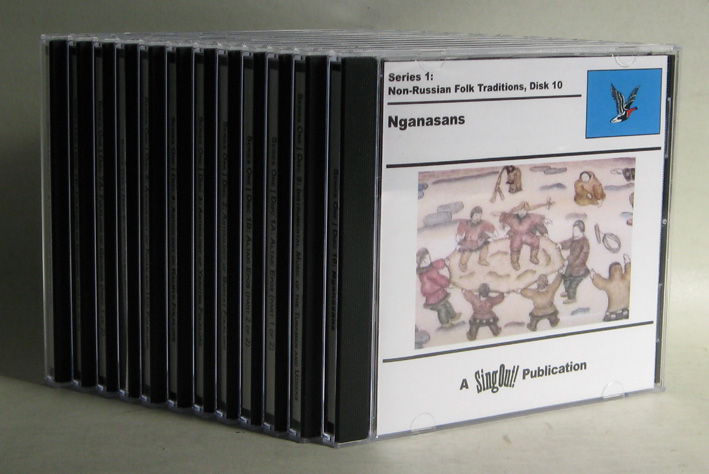 |
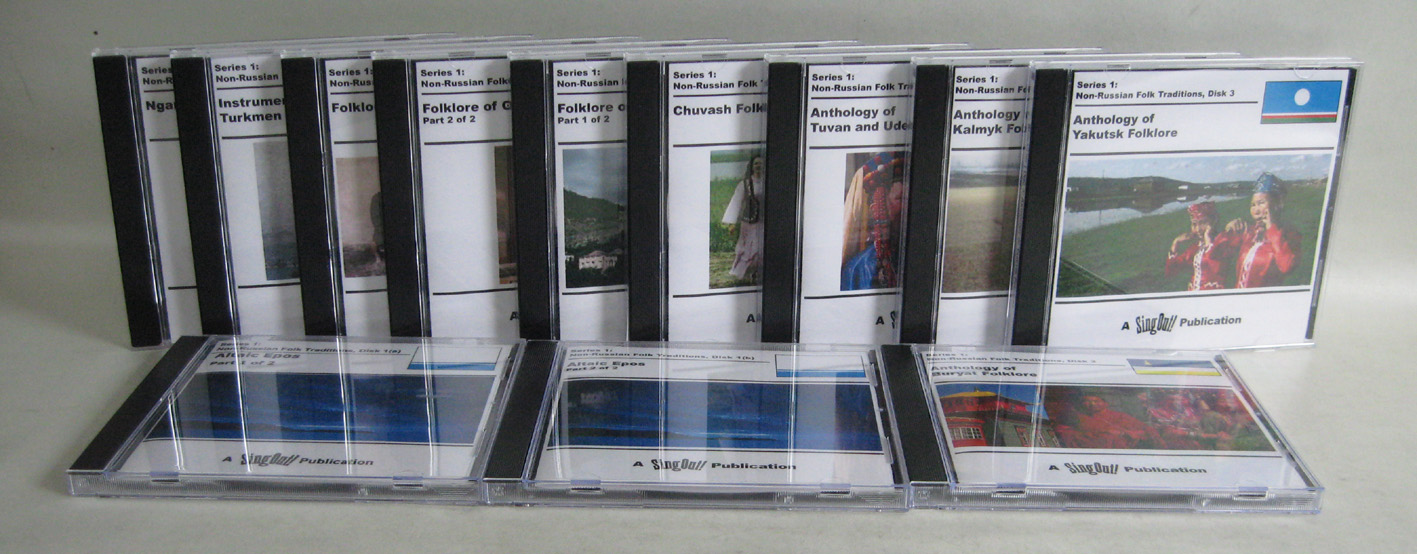 |
|
|
Series II : Russian Folk Traditions. (15 titles, 16 discs)
ロシアの民俗伝統 ¥88,000. (¥96,800 税込)
素晴らしい民俗音楽, ライブ民謡の実演と現地記録のコレクション。ロシア民族音楽のルーツは遠く、スラブ民族が現在のロシア地域であるヨーロッパ地方に定着した紀元後千年のなかばに戻ります。古代ビザンチンとドイツ人文書、それらの民族は、音楽、歌謡、舞踊の愛と卓越で有名でありました。
| 1. |
Былины Russian Epics:ロシア叙事詩
|
| |
Scholars employ the term bylina for Russian epics, a word that is derived from the past tense of the verb ‘to be’ and implies something that was. There are several basic characteristics of the Russian oral epic tradition: the bylines had survived among the peasants in northern Russia, they were usually performed by a single person, they were sung to a distinct kind of melody, they had no instrumental accompaniment, many subjects or themes existed in variants. |
| |
|
| 2. |
Баллады Ballads:バラード
|
| |
Ballads are defined as short traditional narrative songs, with or without accompaniment or dance, in assemblies of the people. Traditional Russian ballads depict, for example, an incessant warfare against infidels, tell of the life of the Courts and of the nobility. |
| |
|
| 3. |
Исторические песни Historical Songs:歴史的な歌
|
| |
Authentic epic traditions have survived to modern times in the oral peasant folklore of the Russian North and with Don Cossacks. Themes of this epic poetic form are courage, love, patriotism, battle and devotion. |
| |
|
| 4. |
Духовные стихи Spiritual Poetry:霊的詩歌
|
| |
Spiritual poems carry the listener into the realm of Russian folk music. |
| |
|
| 5. |
Плачи-причитания Русского Севера (выполнено)
Lamentations of the Russian North:ロシア北部の哀悼歌 |
| |
In lamentations in the dialects of the Russian North regions (Pechora, Archangel, etc.), one can find the traces of very ancient states of the Russian language. |
| |
|
| 6. |
Песни и причитания свадебного обряда
Wedding Songs and Incantations:結婚歌謡と哀悼歌 |
| |
Many Russian folksongs have to do with family rituals, weddings being one of the most impressive of them. |
| |
|
| 7. |
Календарные песни (подблюдные, виноградье, дожинные)
[Pagan] Calendar Songs:カレンダーの歌 |
|
A special place in song folklore belongs to calendar song cycle. It consists of smaller cycles timed to seasons and pagan festivals (often overlaid with Christian holidays). These songs are peculiar for strict regulation and rigidity of short tonal and rhythmic formulas in every cycle. |
| |
|
| 8. |
Лирические песни Lurical Songs:叙情歌
|
| |
Lyrical song and its highest type?drawling songs?are supposed to have formed in the 16th and 17th centuries in Russia. It is associated with the appearance of the famous folk multivoiced singing of polyphonic or heterophonic types with participation of solo voices. |
| |
|
| 9. |
Рекрутские и солдатские песни Recruit and Soldiers’:徴兵と兵士達の歌
|
| |
The recruit songs came into being as the result of Peter I’s enforcement of compulsory military service. They are full of compassion at the thought of the prospective soldier being torn away from his family. |
| |
|
| 10. |
Сказки Fairy Tales:お伽ばなし
|
| |
Russian fairy tales are imaginative and exciting stories involving supernatural people or events. Fairy tales have common elements, usually featuring folkloric characters, such as witches, giants or talking animals. |
| |
|
| 11. |
Частушки Limericks:五行俗謡
|
| |
Limericks (short comic songs of two or four lines) are a more recent Russian folklore genre that got widely spread in the 19th century. |
| |
|
| 12. |
Детский фольклор (колыбельные, потешки, приблутки, считалки) Children’s Folklore (Lullabies):童謡(子守歌)
|
| |
The lullaby is the first genre of folklore encountered by the child. The infant, according to traditional ideas and ritual practice, is a transitional and incomplete being. Such beliefs directly affect the functions of the lullaby, which are lulling to sleep and protection. |
| |
|
| 13. |
Магическая и бытовая проза (заговоры, приговоры, былички, бывальщины) Incantations:呪文
|
| |
An incantation consists of the words spoken during a ritual, either a hymn or prayer, invoking or praising a deity, or in magic, occultism or witchcraft with the intention of casting a spell on an object or a person. Incantations have sources both in paganism and Christian beliefs. |
| |
|
| 14. |
Инструментальные наигрыши (пастушеский рожок, барабанка, балалайка, гармонь) Instrumental Music (Shepherd’s horn, drum, Balalaika & Accordion):楽器音楽(羊飼いのホルン,ドラム,バラライカ,アコーディオン)
|
| |
Instrumental music was traditionally of much less importance than vocal music because of the orthodox prohibition against using musical instruments in church. Instruments were mainly used by shepherds or as accompaniment for some dances and songs. |
| |
|
| 15. |
Песенные традиции русских духоборов The Song Traditions of Russian Doukhobors (2 disc set):ロシア正教の歌と伝統
|
| |
The Doukhobors, “spirit wrestlers,” were a Christian sect, later defined as a religious philosophy, ethnic group, social movement, which in the 18th century rejected secular government, the Russian Orthodox priests, icons, all church ritual, the Bible as the supreme source of divine revelation and the divinity of Jesus. At their prayer meetings and gatherings they sang a cappella psalms, hymns and spiritual songs. |
| |
|
| |
|
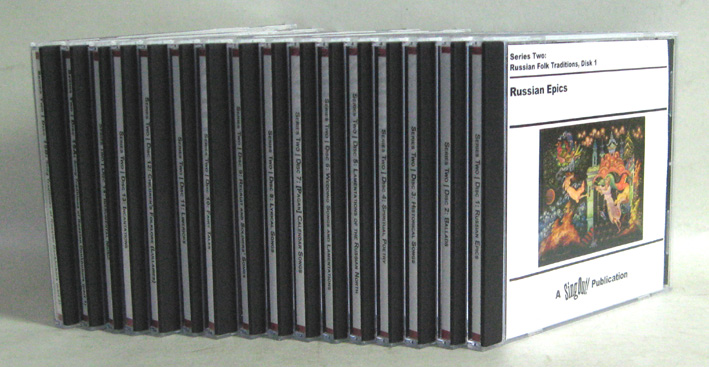 |
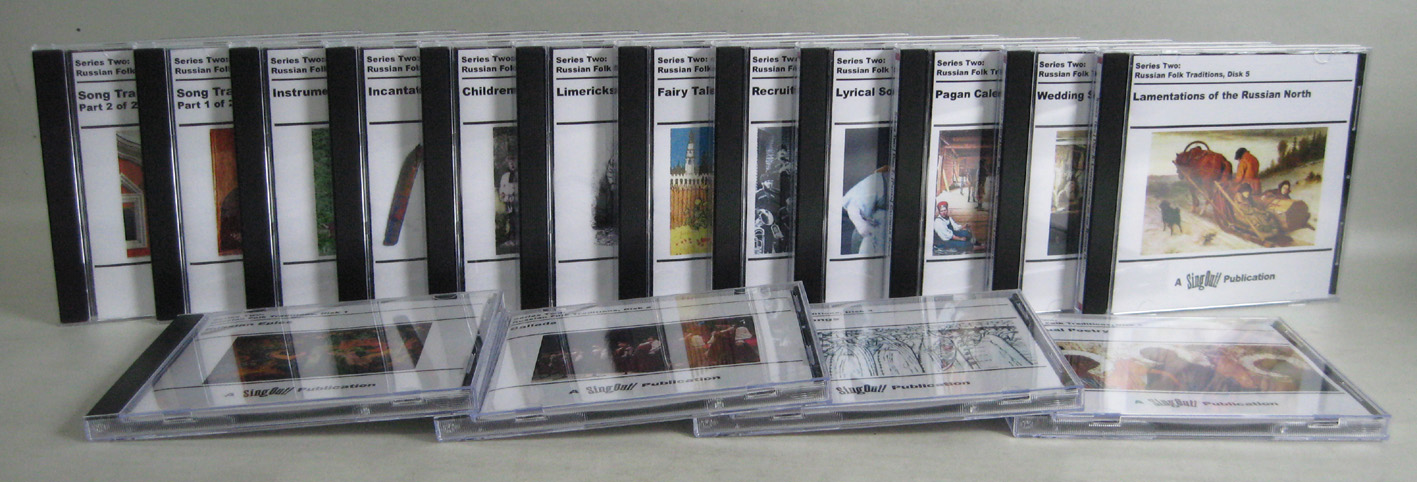 |
|
|
Series III: Russian and Non-Russian Folk Traditions. (9 titles, 10 discs)
ロシア と 非ロシアの民俗伝統 ¥55,000. (¥60,500 税込)
| 1. |
Традиционный фольклор коряков и эскимосов
(Traditional Folklore of Koryaks & Eskimos:コリアクとエスキモの伝統的民間伝承) |
| |
The Koryaks live in the Northern part of the Kamchatka Peninsula and on the adjoining land, from the Taigonos Peninsula to the Bering Sea. The population is less than 10,000. A great number of the ethnic Eskimos have been assimilated, either by the Russians or the Chukchis, but the Siberian Eskimos have retained 16 settlements on the eastern coast of the Chukchi Peninsula. According to the 1989 census, there were only 1,718 Siberian Eskimos. |
| 2. |
Традиционный фольклор нанайцев и эвенов
(Traditional Folklore of Nanaians & Evens:ナナイアンとエヴェンの伝統的民間伝承) |
| |
The Nanaians (Nanais) live in the Far East on the River Amur, downstream from the city of Khabarovsk. Russians have called the Nanaians “Golds.” The 1989 Russian and USSR population census reads as follows: 12,017 people. The Evens inhabit a large territory in the Khabarovsk district, the Magadan region, the northern part of Yakutia, the Chukchi, and the Kamchatka Peninsula. The population is 17,199. |
| 3. |
Традиционный фольклор нивхов
(Traditional Folklore of Nivhis:ニブヒの伝統的民間伝承) |
| |
The Nivhis (Nivkhs) live on the Lower Amur, on the coast of the Ohkotsk Sea on the river’s estuary, and on Sakhalin Island. The earliest historical data concerning the Nivkhs dates back to a 12th-century Chinese chronicle. The following census data is given for the Nivkhs for 1989: 4,673 people. |
| 4. |
Традиционный фольклор чукчей и ительменов
(Traditional Folklore of Chukchis and Itelmens:チュクチとイテルメンの伝統的民間伝承) |
| |
The Chukchis live in the extreme northeastern part of Siberia, in the area between the Chukchi and Bering Seas. Life for the Chukchis means privation, cold and a constant struggle for existence, but also freedom and proud self-sufficiency. The 1989 census registered 15,183 Chukchis. The Itelmens inhabit the area between Sedanka and Sopochnoye on the western coast of the Kamchatka Peninsula. In the 18th century they inhabited almost the whole of the peninsula, but their habitat later decreased considerably (to 2,480 people). |
| 5. |
Бассейн рек Лены и Индигирки
(The Region of Rivers Lena and Indigirka:レナ河とインディギルカ河地方) |
| |
With its source in the Baikal Mountains, The Lena, 10th longest river in the world, flows northeast to the Laptev Sea. The Indigirka River of the Sakha Republic flows into the East Siberian Sea. The basins of these rivers are home for many indigenous peoples of Siberia and the Far East of Russia. |
| 6. |
Полный обряд шаманского камлания: нганасаны (a 2-disc set)
(Shamanskoe Kamlanie: Nganasans:ガナサン人 中央シベリアのサモイエド系先住民族) |
| |
The Nganasans are the northernmost of the Samoyedic peoples, living on the Taymyr Peninsula in the Arctic Ocean. According to the census, there were 1,278 Nganasans in 1989. The Nganasans have never had a written language. |
| 7. |
Традиционный фольклор Пинежья
(Traditional Folklore of Pinega Region:ピネガ地方の伝統的民間伝承) |
| |
The Pinega is a river in the Archangel Region of Russia and a tributary of the North Dvina River. According to the 2002 Census, ethnic Russians made up 94% of the population in this area. |
| 8. |
Фольклор Северной Двины и ее притоков
(Folklore of North Dvina and her Tributaries:ドヴィナと其の属国の民間伝承) |
| |
The mighty North Dvina begins in the Vologda Region, flows from the southeast to the northwest through the whole of the Archangel Region and empties into the Dvina Bay of the White Sea. Here, where three cultural components ? “the culture of sea,” “the culture of forest” and “the culture of field” ? met, the phenomenon called “Pomor Culture” arose. |
| 9. |
Песни русско-белорусско-украинскогопограничья
(The Songs of Russian-Belarusian-Ukrainian Border:ロシア、ベラルーシュ,ウクライナ国境の歌) |
| |
Russians, Belarusians and Ukrainians not only share borders; the three nations also share traditions, customs and folklore style. |
 |
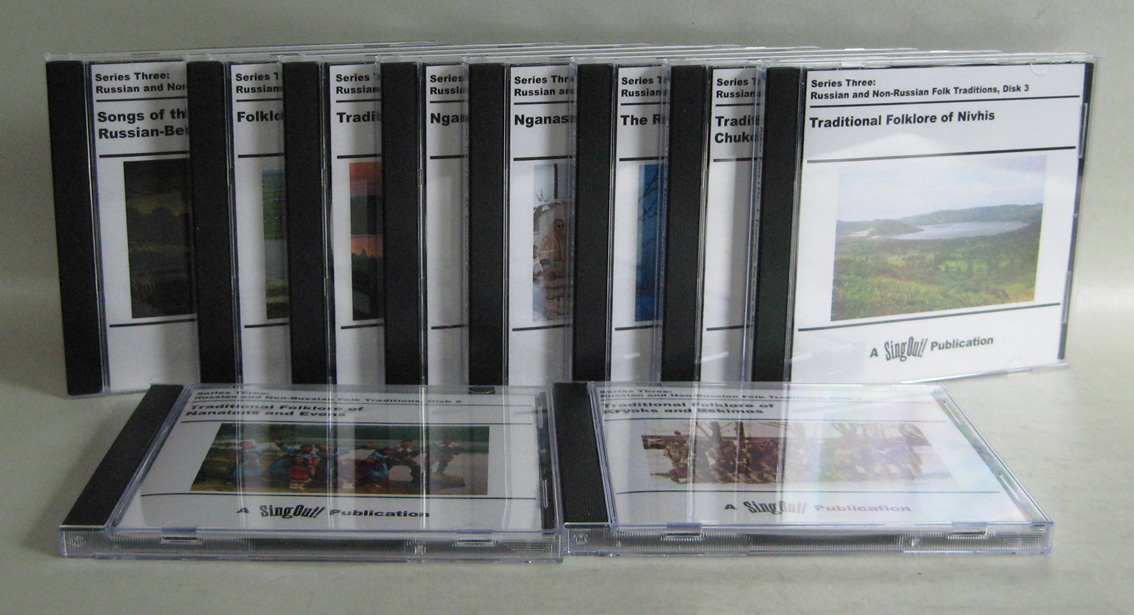 |
|
|
|